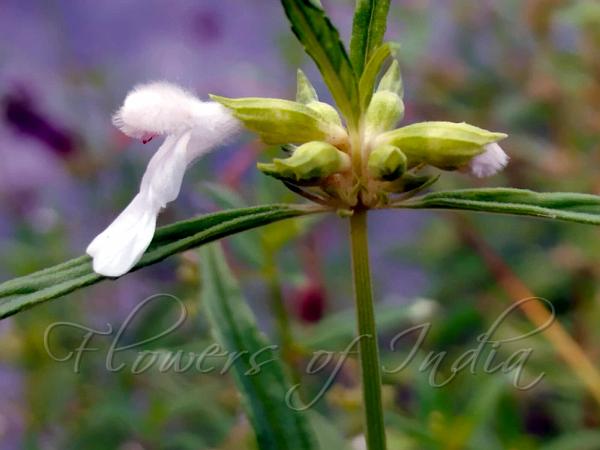|
| Lavender-Leaf Leucas |
|

|

|
|
|
|
Photo: |
Botanical name: Leucas lavandulifolia Family: Lamiaceae (Mint family)
Synonyms: Leucas linifolia, Leucas malabarica
Synonyms: Leucas linifolia, Leucas malabarica
Lavender-Leaved Leucas is an annual herb, up to 40
cm tall; branches finely velvet-hairy. Leaves are 4-7 x 0.6-1.3 cm,
linear-lanceshaped, base narrowed, margin subentire, tip pointed, hairy
on veins and on margins; leaf-stalk 4-5 mm long. Flowers are borne in
dense, separated clusters, in leaf-axils. Bract are 5-6 mm long,
linear, hairy. Calyx tube is 4-5 mm long, tubular, prominently oblique,
slightly curved, velvet-hairy, shortly 8-toothed, one slightly longer.
Flowers are white; tube 2-3 mm long, 2-lipped; upper lip 1-2 mm long,
lower 5-6 mm long, 3-lobed. Stamens 4, didynamous; filaments sparsely
hairy. Ovary 4-celled; ovules 4; stigma 2-fid. Nutlets 4, minute.
Lavender-Leaved Leucas is found in Indo-Malesia and East Asia.
It is found in the Himalayas, from Nepal to NE India, at altitudes up to
1000 m.
Medicinal uses: Leaf juice is used to treat
stomach complaints. It is also applied to poisonous insect-bites. The
paste of tender shoots is applied to relieve headache.
Leaf juice is used to treat
stomach complaints. It is also applied to poisonous insect-bites. The
paste of tender shoots is applied to relieve headache.
Medicinal uses:
 Leaf juice is used to treat
stomach complaints. It is also applied to poisonous insect-bites. The
paste of tender shoots is applied to relieve headache.
Leaf juice is used to treat
stomach complaints. It is also applied to poisonous insect-bites. The
paste of tender shoots is applied to relieve headache. | Identification credit: Karuna Kanta Das | Photographed in North Lakhimpur, Assam & Siliguri, West Bengal. |
• Is this flower misidentified? If yes,